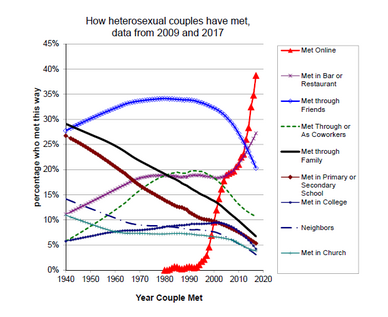
Foreplay is a set of emotionally and physically intimate acts between one or more people meant to create sexual arousal and desire for sexual activity. Although foreplay is typically understood as physical sexual activity, nonphysical activities, such as mental or verbal acts, may in some contexts be foreplay. This is typically the reason why foreplay tends to be an ambiguous term and means different things to different people. It can consist of various sexual practices such as kissing, sexual touching, removing clothes, oral sex, manual sex, sexual games, and role playing.
In social psychology, an interpersonal relation describes a social association, connection, or affiliation between two or more persons. It overlaps significantly with the concept of social relations, which are the fundamental unit of analysis within the social sciences. Relations vary in degrees of intimacy, self-disclosure, duration, reciprocity, and power distribution. The main themes or trends of the interpersonal relations are: family, kinship, friendship, love, marriage, business, employment, clubs, neighborhoods, ethical values, support and solidarity. Interpersonal relations may be regulated by law, custom, or mutual agreement, and form the basis of social groups and societies. They appear when people communicate or act with each other within specific social contexts, and they thrive on equitable and reciprocal compromises.

Sexual attraction is attraction on the basis of sexual desire or the quality of arousing such interest. Sexual attractiveness or sex appeal is an individual's ability to attract other people sexually, and is a factor in sexual selection or mate choice. The attraction can be to the physical or other qualities or traits of a person, or to such qualities in the context where they appear. The attraction may be to a person's aesthetics, movements, voice, or smell, among other things. The attraction may be enhanced by a person's adornments, clothing, perfume or hair style. It can be influenced by individual genetic, psychological, or cultural factors, or to other, more amorphous qualities. Sexual attraction is also a response to another person that depends on a combination of the person possessing the traits and on the criteria of the person who is attracted.

Physical intimacy is sensuous proximity or touching. It is an act or reaction, such as an expression of feelings, between people. Examples of physical intimacy include being inside someone's personal space, holding hands, hugging, kissing, caressing and sexual activity. Physical intimacy can often convey the real meaning or intention of an interaction in a way that accompanying speech cannot do. Physical intimacy can be exchanged between any people but as it is often used to communicate positive and intimate feelings, it most often occurs in people who have a preexisting relationship, whether familial, platonic or romantic, with romantic relationships having increased physical intimacy. Several forms of romantic touch have been noted including holding hands, hugging, kissing, cuddling, as well as caressing and massaging. Physical affection is highly correlated with overall relationship and partner satisfaction.

Romance or romantic love is a feeling of love for, or a strong attraction towards another person, and the courtship behaviors undertaken by an individual to express those overall feelings and resultant emotions.

A sexual fantasy or erotic fantasy is an autoerotic mental image or pattern of thought that stirs a person's sexuality and can create or enhance sexual arousal. A sexual fantasy can be created by the person's imagination or memory, and may be triggered autonomously or by external stimulation such as erotic literature or pornography, a physical object, or sexual attraction to another person. Anything that may give rise to a sexual arousal may also produce a sexual fantasy, and sexual arousal may in turn give rise to fantasies.

Infidelity is a violation of a couple's emotional and/or sexual exclusivity that commonly results in feelings of anger, sexual jealousy, and rivalry.
Interpersonal attraction, as a part of social psychology, is the study of the attraction between people which leads to the development of platonic or romantic relationships. It is distinct from perceptions such as physical attractiveness, and involves views of what is and what is not considered beautiful or attractive.
The triangular theory of love is a theory of love developed by Robert Sternberg. In the context of interpersonal relationships, "the three components of love, according to the triangular theory, are an intimacy component, a passion component, and a commitment component."

Sexual jealousy is a special form of jealousy in sexual relationships, based on suspected or imminent sexual infidelity. The concept is studied in the field of evolutionary psychology.
Emotional dysregulation is characterized by an inability in flexibly responding to and managing emotional states, resulting in intense and prolonged emotional reactions that deviate from social norms, given the nature of the environmental stimuli encountered. Such reactions not only deviate from accepted social norms but also surpass what is informally deemed appropriate or proportional to the encountered stimuli.
Caring in intimate relationships is the practice of providing care and support to an intimate relationship partner. Caregiving behaviours are aimed at reducing the partner's distress and supporting their coping efforts in situations of either threat or challenge. Caregiving may include emotional support and/or instrumental support. Effective caregiving behaviour enhances the care-recipient's psychological well-being, as well as the quality of the relationship between the caregiver and the care-recipient. However, certain suboptimal caregiving strategies may be either ineffective or even detrimental to coping.
In psychology, the theory of attachment can be applied to adult relationships including friendships, emotional affairs, adult romantic and carnal relationships and, in some cases, relationships with inanimate objects. Attachment theory, initially studied in the 1960s and 1970s primarily in the context of children and parents, was extended to adult relationships in the late 1980s. The working models of children found in Bowlby's attachment theory form a pattern of interaction that is likely to continue influencing adult relationships.
The social penetration theory (SPT) proposes that as relationships develop, interpersonal communication moves from relatively shallow, non-intimate levels to deeper, more intimate ones. The theory was formulated by psychologists Irwin Altman of the University of Utah and Dalmas Taylor of the University of Delaware in 1973 to understand relationship development between individuals. Altman and Taylor noted that relationships "involve different levels of intimacy of exchange or degree of social penetration". SPT is known as an objective theory as opposed to an interpretive theory, meaning it is based on data drawn from actual experiments and not simply from conclusions based on individuals' specific experiences.
Intimate partner violence (IPV) is domestic violence by a current or former spouse or partner in an intimate relationship against the other spouse or partner. IPV can take a number of forms, including physical, verbal, emotional, economic and sexual abuse. The World Health Organization (WHO) defines IPV as "any behavior within an intimate relationship that causes physical, psychological or sexual harm to those in the relationship, including acts of physical aggression, sexual coercion, psychological abuse and controlling behaviors." IPV is sometimes referred to simply as battery, or as spouse or partner abuse.

Pornography has been defined as any material in varying forms, including texts, video, photos or audio that is consumed for sexual satisfaction and arousal of an individual or partnership. The effects of pornography on individuals or their intimate relationships depend on the type of pornography used and differs from person to person. The consumption of pornographic material could have both positive and negative outcomes.
Domestic violence within lesbian relationships is the pattern of violent and coercive behavior in a female same-sex relationship wherein a lesbian or other non-heterosexual woman seeks to control the thoughts, beliefs, or conduct of her female intimate partner. In the case of multiple forms of domestic partner abuse, it is also referred to as lesbian battering.
A duocentric social network is a type of social network composed of the combined network members of a dyad. The network consists of mutual, overlapping ties between members of the dyad as well as non-mutual ties. While an explicit conceptualization of duocentric social networks appeared for the first time in an academic publication in 2008, the history of the analysis dates back to at least the 1950s and has spanned the fields of psychology, sociology, and health.
Relationship science is an interdisciplinary field dedicated to the scientific study of interpersonal relationship processes. Due to its interdisciplinary nature, relationship science is made-up of researchers of various professional backgrounds within psychology and outside of psychology, but most researchers who identify with the field are psychologists by training. Additionally, the field's emphasis has historically been close and intimate relationships, which includes predominantly dating and married couples, parent-child relationships, and friendships & social networks, but some also study less salient social relationships such as colleagues and acquaintances.
Relational mobility is a sociological variable that represents how much freedom individuals have to choose which persons to have relationships with, including friendships, working relationships, and romantic partnerships in a given society. Societies with low relational mobility have less flexible interpersonal networks. People form relationships based on circumstance rather than active choice. In these societies, relationships are more stable and guaranteed, while there are fewer opportunities to leave unsatisfying relationships and find new ones. Group memberships tend to be fixed, and individuals have less freedom to select or change these relationships even if they wished to.












